Who Controls the User Experience? AMD’s Carrizo Thoroughly Tested
by Ian Cutress on February 4, 2016 8:00 AM ESTBenchmark Results: Professional and OpenCL
Here are our results from our Professional and OpenCL tests. A reminder of our systems, including their graphics:
| System Overview | ||||
| µArch | APU + GPU | Memory | Channel | |
| HP Elitebook 745 G2 | Kaveri | A10 PRO-7350B (19W) R6, 384 SPs, 533 MHz |
8 GB | Dual |
| HP Elitebook 745 G3 | Carrizo | PRO A12-8800B (15W) R7, 512 SPs, 800 MHz |
4 GB | Single |
| Toshiba Satellite E45DW-C4210 |
Carrizo | FX-8800P (15W) R7, 512 SPs, 800 MHz |
8 GB | Single |
| HP Pavilion 17z-g100 |
Carrizo | A10-8700P (15W) R6, 384 SPs, 800 MHz |
8 GB | Single |
| Lenovo Y700 | Carrizo | FX-8800P (15W) R7, 512 SPs, 800 MHz R9 385MX, 512 SPs, 900-100 MHz |
16 GB | Single |
PCMark 08
PCMark08, developed by Futuremark, is a simple press play and run benchmarking tool designed to probe how well systems cope with a variety of standard tasks that a professional user might encounter. This includes video conferencing with multiple streams, image/file manipulation, video processing, 3D modelling and other tools. In this case we take the three main benchmark sets, Creative, Home and Work, and run them in OpenCL mode which aims to take advantage of OpenCL accelerated hardware. For fun we also put in the PCMark08 Storage workset.
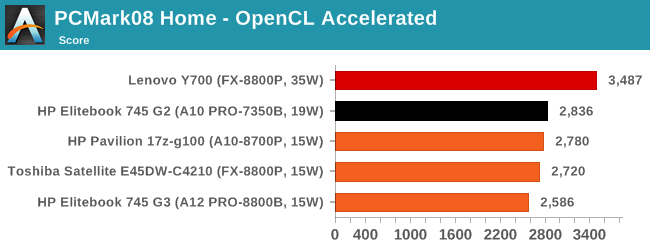
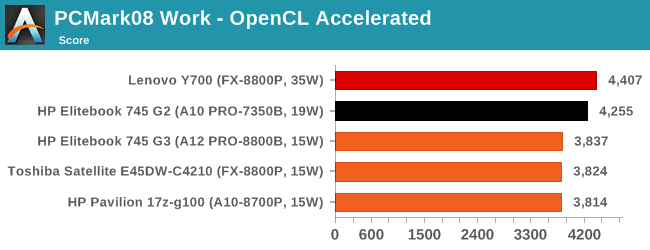
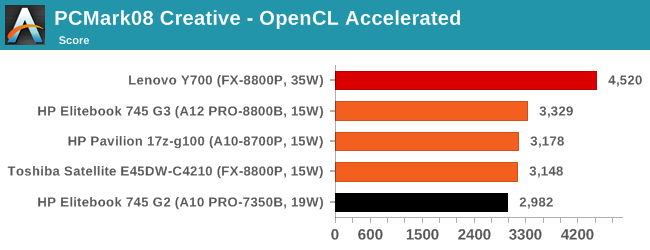
Both of the Home and Work tests show something starteling in the Kaveri system beating all the 15W Carrizo parts. This comes back to what we saw on WebXPRT on the last page – these workloads are very bursty in nature, requiring the system to wake up, run a small amount of work, and go back to sleep. It would seem that this requires a lot more effort from the Carrizo platforms than the Kaveri ones (perhaps by nature of the lower idle power draw starting point on Carrizo) which impacts time critical performance metrics.
If we take the CPU frequencies of the two Elitebook systems, starting with the 745 G2 (Kaveri)
Here the standard frequency tends to be in the 3300 MHz region, moving down to lower frequencies when more threads are needed. But for the 745 G3 (Carrizo):
Here the CPU frequency is obviously mostly at the 2500 MHz mark, sometimes bursting up to 3400 MHz (It’s actually more of a 2:1 split in favor of 2500 MHz).
You might argue that the temperature of the design might be to blame. Both Elitebooks are in the same chassis, so let us see:
(take note of the scales)
Here it shows the G2 wanting to stay below 60C, whereas the G3 is happy to go almost to 80C, albeit with an average temperature which is nearer 50C. This means that the G2 can arguably keep the higher frequencies for longer.
Just to weigh in on the other 15W Carrizo designs in the Toshiba Satellite and HP Pavilion:
In both cases, similar to the G3, the main frequency for the test is actually the lower 2500/2300 frequency, with the system moving up to the higher frequency state around a third of the time, rather than staying at the higher state and moving back down. This is what is causing the Kaveri system to win out in these sorts of workloads (though likely at a power penalty).
On the storage front, having a mechanical drive is a killer here.

Agisoft Photoscan
Photoscan is professional software that takes a series of 2D images (as little as 50, usually 250+) and 'performs calculations' to determine where the pictures were taken and if it can create a 3D model and textures of what the images are of. This model can then be exported to other software for touch-ups or implementation in physics engines/games or, as the reader that directed me to it, national archiving. The tool has four phases, one of which can be OpenCL accelerated, while the other three are a mix of single thread and variable thread workloads. We ran the tool in CPU only and OpenCL modes.
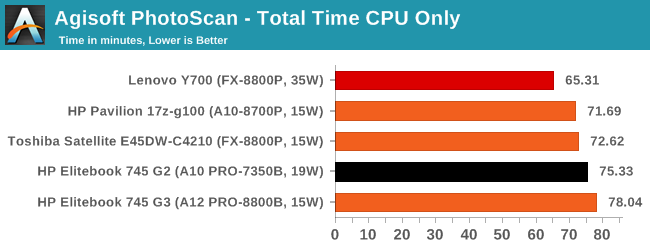
When pure CPU performance matters, having the higher thermal headroom matters most. But moving it to the OpenCL mode shows that those extra TDP points can matter a lot on load balancing:
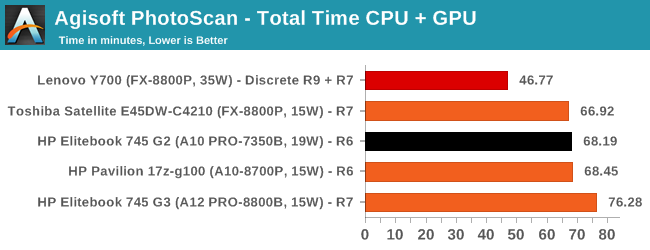
There are two things to note here. One, something seems to have gone very wrong with the G3, and I’m sure those numbers are erroneous and need to be re-run or the 4GB of memory is actually a hindrance here. The second is that the combination R7/R9 graphics in the Lenovo, despite not being in Crossfire, can both be used in OpenCL mode. This pushes a speed up of almost 30%.
Linux Bench
Linux Bench is a collection of Linux based benchmarks compiled together by ServeTheHome. The idea for this is to have some non-windows based tools that are easy enough to run with a USB key, an internet connection and three lines of code in a terminal. The tests in Linux Bench include standard synthetic compute, compression, matrix manipulation, database tools and key-value storage.
Unfortunately Linux Bench refused to run on any of the HP systems for relatively unknown reasons – the fact that it was all the HP models perhaps means that there is something firmware related which is causing the LiveCD to not boot properly. Nonetheless, the results are here for completeness.
| Linux Bench | ||
| Toshiba Satellite E45DW-C4210 (15W) |
Lenovo Y700 (35W) |
|
| C-Ray Hard Test / seconds | 365 | 267 |
| 7-Zip Compression MIPS | 5718 | 6110 |
| 7-Zip Decompression MIPS | 7320 | 9733 |
| NAMD (steps per time) | 1.72 | 2.46 |
| NPB MOPS (per sec per thread) | 365 | 321 |
| OpenSSL Sign | 220 | 296 |
| OpenSSL Verify | 13518 | 19465 |
| Redis 1 | 13210 | 12034 |
| Redis 10 | 41494 | 38760 |
| Redis 100 | 33445 | 31949 |






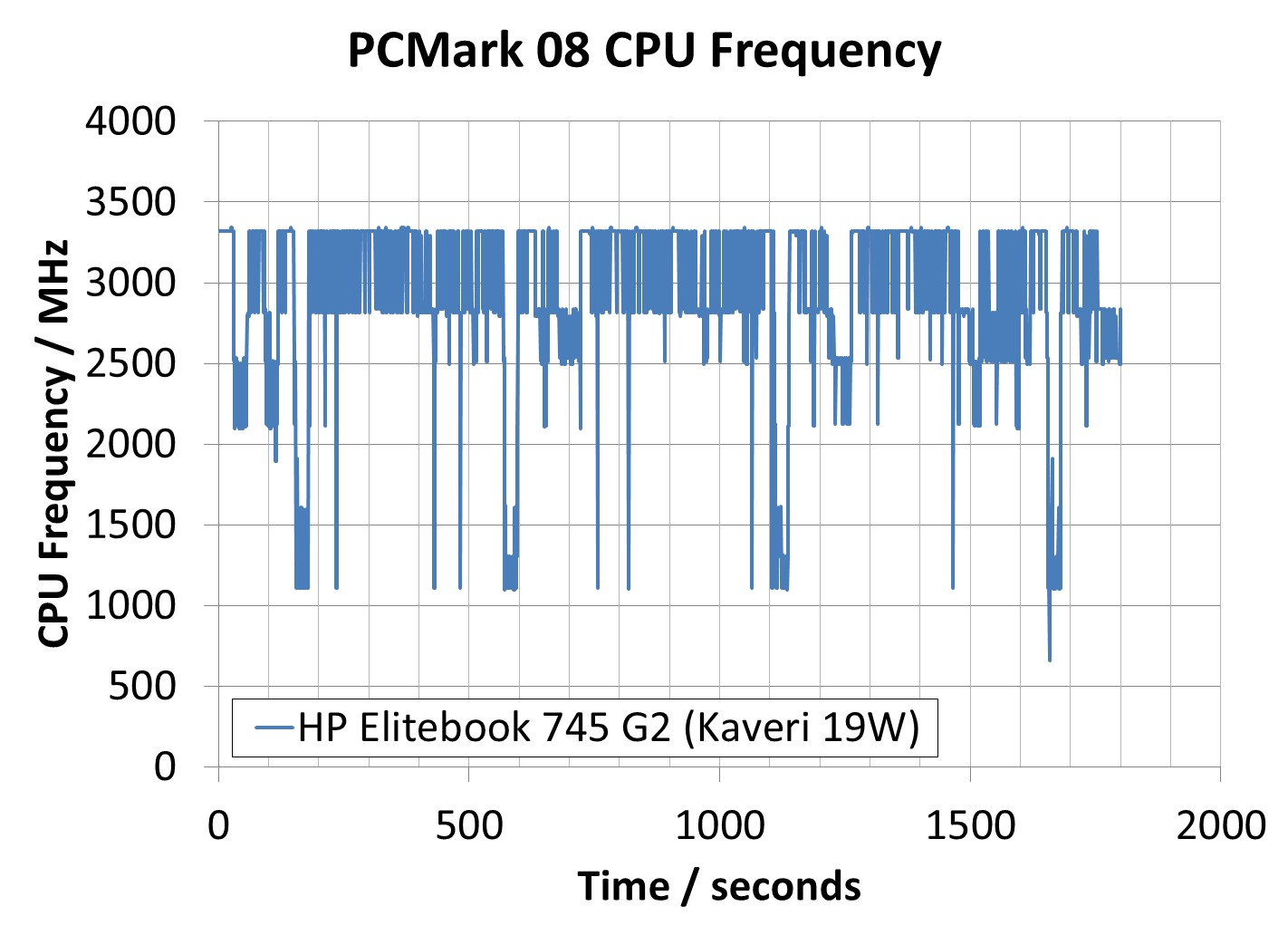

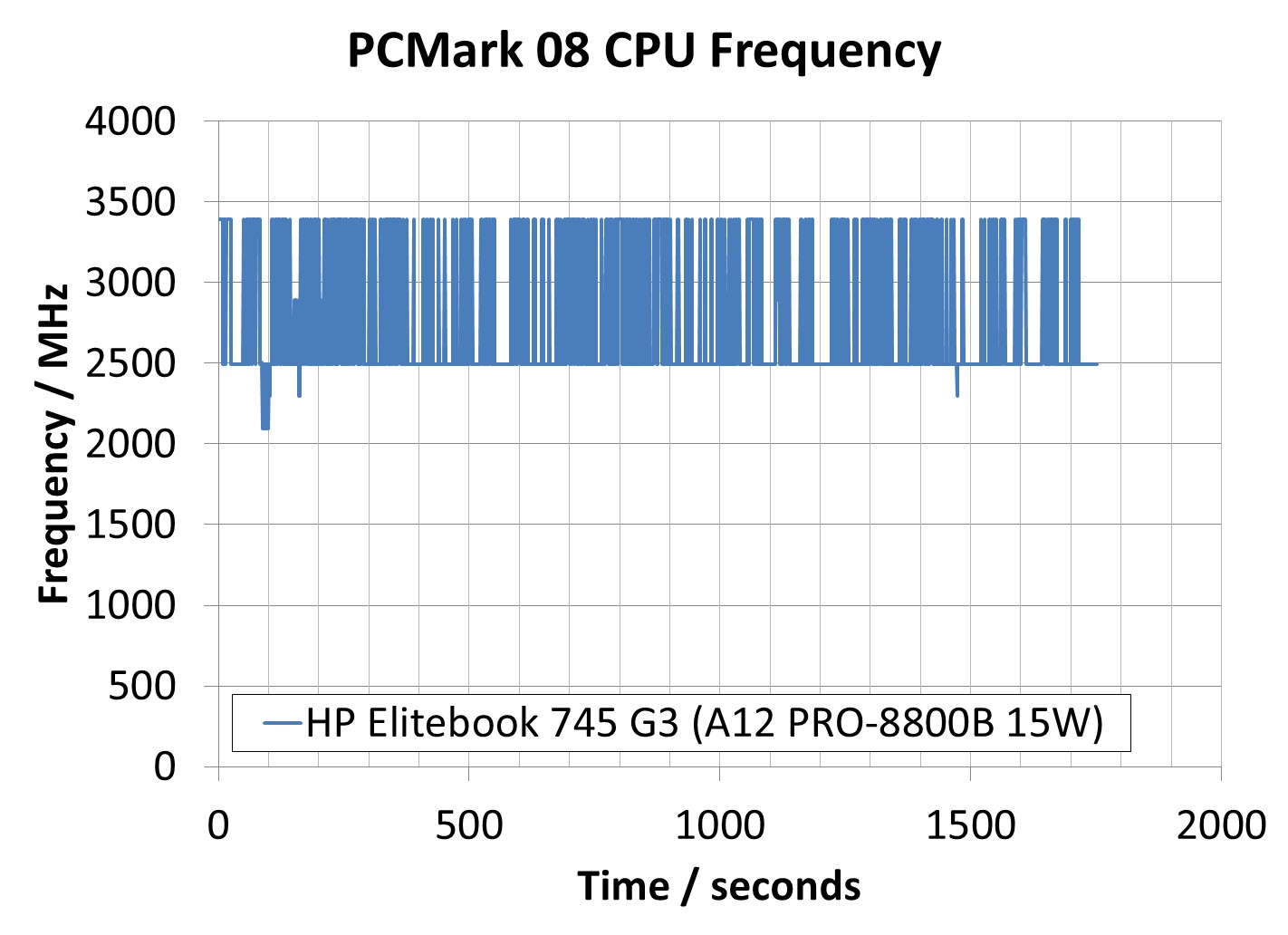
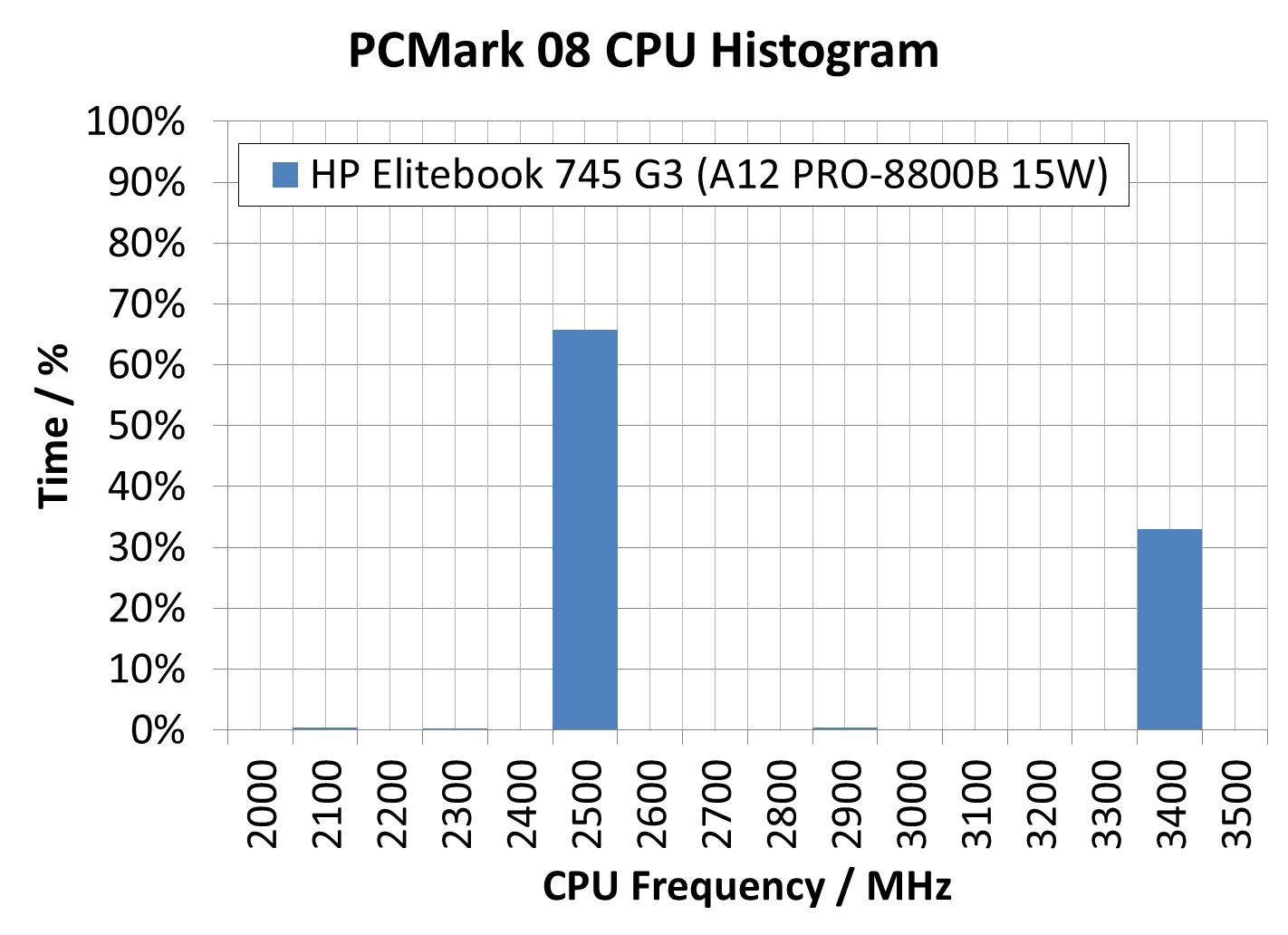

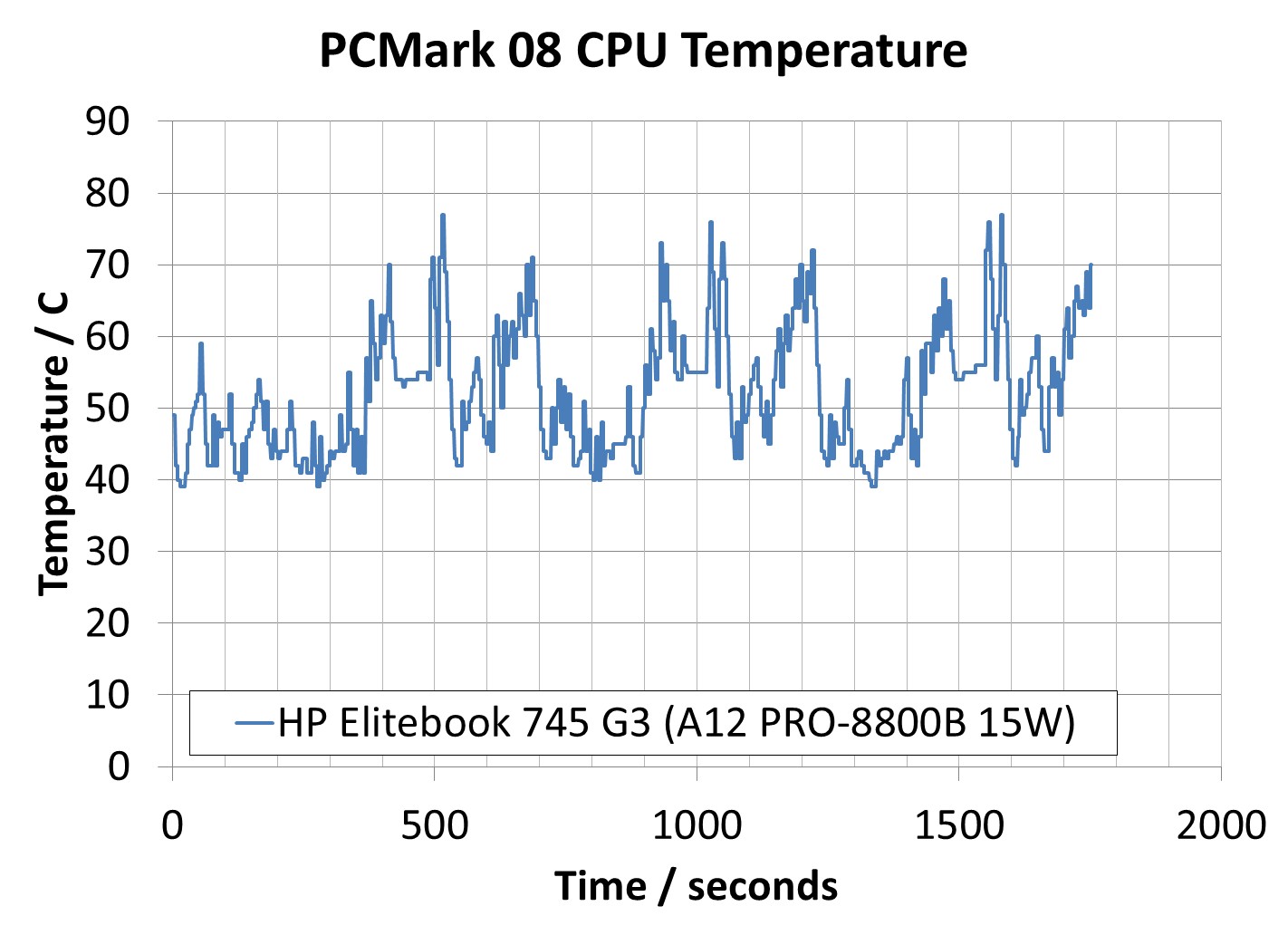










175 Comments
View All Comments
basicmath - Tuesday, February 9, 2016 - link
No it's really not, this laptop came from the factory with dual channel capability but that capability was not utilised because that would have shown the platform in a much better light, he even states that he checked the chips in the G2 to confirm that it was single channel. Upgrading the RAM on a laptop is a simple process that any end user can perform. The only discernible difference between the APU in the G2 & G3 is the number of GPU cores so why did he even bother testing the G3 without using dual channel configuration?Intel999 - Sunday, February 7, 2016 - link
@IanI look forward to that R-series test as it will provide a sneak peek at how much DDR4 relieves the bottleneck on integrated graphics when Bristol Ridge comes out.
That $70 Athlon X4 845 is intriguing as well.
AS118 - Saturday, February 6, 2016 - link
Good article (although to be fair, I mostly skimmed it), and I agree with the conclusions. AMD should try harder to make sure their high-end products are paired with good components. Single-channel ram, bad screens, and slow hard drives with an A10 or mobile FX defeats the purpose of having those higher end APU's.Plus, people will get a bad impression of AMD if a lot of them have poor trackpads, etc. I wish they'd make their own "signature" brand of laptops, and find someone to help make them a thing.
TheinsanegamerN - Thursday, February 11, 2016 - link
Both clevo and MSI have treated AMD well before, Im sure either would love to have exclusive rights to the high end AMD notebook.That being said, I doubt AMD has the intelligence to pull it off. They seem to be run by monkeys 90% of the time.
Cryio - Saturday, February 6, 2016 - link
I'm really sorry for AMD. Kaveri and Carizzo on mobile, when configured to the proper ram, cooling and when using the highest performing part ... would've provided awesome performance, compared to Haswell and Broadwell. But no one bothered.Bristol Ridge will basically be Carizzo with DDR4 support and since it will be even better binned 28 nm CPUs, maybe we'll get even higher frequency out of Excavator. As for GCN 2.0 GPUs ... it will be interesting to see.
I love my Surface Pro 4, even given the disaster that is Skylake drivers and Windows 10 horrible efficiency compared to W8.1. But MAN. I would've loved a proper Carrizo based Surface Pro/Book.
Gadgety - Saturday, February 6, 2016 - link
A confirmation, with in depth detail. Nice write up.Khenglish - Sunday, February 7, 2016 - link
I would have really liked to see some dual channel results, or at least pulling a memory stick from the Kaveri and Intel systems to get a fair comparison. AMD says Zen brings a 40% IPC improvement. It'd be great to have a baseline to see if that 40% improvement is enough. In the dual channel intel to single channel AMD comparisons it does not appear to be enough, but we don't know how big of a factor memory was.Jon Irenicus - Sunday, February 7, 2016 - link
I want to buy an amd part for my next notebook but as was mentioned in the article, oems only choose bargain basement platforms to put the amd inside. The elitebook is the one exception, along with the lenovo if you don't mind the bulk.But the elitebooks are super overpriced for what you get. They need to release an hp spectre version of a notebook with a zen apu, a dell xps notebook variant with an apu. Ideally, the models that include a discreet gpu should allow the apu to work in tandem.
In 2017 dx12 will be in full effect with games, and having two gpus working together by default could give a lot of amd equipped systems a larger edge, especially if the oversized ipc deficits between excavator and intel parts is minimized with zen.
The future really does rest on Zen, amd needs to laser focus on performance per watt and ipc, and equip the 2017 apus with polaris gpu parts or vega or whatever the first iterations will be called. That has to be the minimum. Put those in nice chassis with solid battery life and that is all they need.
Intel999 - Sunday, February 7, 2016 - link
In DX12 dual graphics will be automatic. Even an Intel Igpu combined with a discrete Nvidia or AMD GPU will "merge" the graphic capabilities in the laptop.Theoretically, an AMD APU combined with an AMD GPU might have an advantage as all graphics would be from the same underlying graphic architecture. Time will tell if this bares out.
Ryan Smith - Monday, February 8, 2016 - link
Note that it's only going to be as automatic as the game developer makes it, as devs will be responsible for implementing it. For the moment game devs are going to be the wildcard.